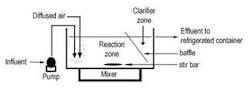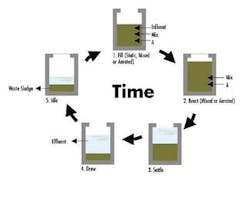Bench-Scale Testing Evaluates Treatment System Performance
By Heather L. Frost, Robert L. Irvine and David A. Irvine
A pigment production facility that used an on-site wastewater treatment plant (WWTP) to process its wastewater planned to increase pigment production. The company became concerned that the increase would generate more wastewater than the WWTP was designed to accommodate. A detailed wastewater loading study and a bench-scale study were conducted to solve this potentially large capacity issue for the WWTP.
The specific objectives of the research investigation included:
• Comparing the process performance (MLSS, SVI, organic removal efficiency, sludge settleability, etc.) of four pre-determined reactor configurations
• Determining which reactor configuration would effectively handle the increased load
To replicate the facility's current operations, a continuous flow stirred tank reactor (CFSTR) was established as the control and three additional reactor configurations were evaluated as part of the bench-scale study, including:
1. Two CFSTRs in series
2. One CFSTR amended with polyurethane foam cubes ("polyurethane foam CFSTR")
3. One Sequencing Batch Reactor (SBR)
Raw waste that was collected from the facility and transported to the bench-scale laboratory was used as the influent in these studies.
Bench-Scale Reactors
Single CFSTR. The single CFSTR consisted of a 9-L polycarbonate reactor with a built-in clarifier. This reactor acted as the control reactor for the bench-scale studies. Influent was continuously introduced into the reactor with the aid of digital variable speed peristaltic pumps. Mixing was provided via a magnetic stir bar and magnetic stirrer. Diffused aeration was supplied via lab air and porous diffuser stones with influx controlled using a pressure regulator and air flow meter. Effluent was gravity withdrawn from the in-built clarifier via a fixed weir. Sludge was wasted manually.
Two CFSTR in Series. An 18-L polycarbonate vessel was used for the two CFSTRs in series configuration. This reactor simulated the effect of operating the full-scale basins in series, instead of the current parallel configuration. The dimensions of the 18-L vessel were identical to the two 9-L CFSTRs placed side by side lengthwise. A baffle was placed in the 18-L vessel to separate it into two interconnected 9-L CFSTRs. The baffle served to minimize short-circuiting and direct influent flow from the first CFSTR into the second CFSTR. A single in-built clarifier located in the second CFSTR was used to control solids loss from this process configuration.
Polyurethane foam CFSTR. The only difference between the polyurethane foam CFSTR and the single CFSTR was the 300 foam cubes of known mass and volume that were added to the reactor zone as a support media for microorganisms. This reactor simulated the effect of adding a foam medium to the existing basins that are operating in parallel.
SBR. The SBR was comprised of a 9-L polycarbonate vessel with similar dimensions to the vessel used for the single CFSTR configuration. The influent pump, mixer, air solenoid valve, and effluent pump were turned on and off at designated times in the SBR operating cycle with the aid of a Chrontrol® Timer.
Process Performance
The study's primary objective was to evaluate the performance of the four bench-scale reactors under the full-scale operating conditions. The initial studies were conducted for four weeks during which the bench-scale reactors were operated at the same HRT (3.1 days), SRT (55 days) and initial MLSS (3,500 mg/L) of the full-scale system. All four reactor configurations were seeded with mixed liquor collected from the return activated sludge line of the full-scale aeration basins.
Unlike the three continuous flow reactor configurations which were operated with the influent pump, mixing, and air on 24 hours a day, the SBR was operated on a periodic basis and was started up on two 12-hour cycles per day that cycled through the five phases of an SBR.
The analytical methods for COD, TSS, MLSS, VSS, MLVSS, and SVI were taken from Standard Methods for the Examination of Water and Wastewater. For NH3-N analysis, a Hach test was used.
Study Results
• MLSS (ppm). For the duration of the initial study, the SBR, the control CFSTR, and the CFSTRs in series configuration all demonstrated a steady MLSS of about 3500 mg/L. Unlike the other three reactors, the biocube's MLSS steadily declined from about 3500 mg/L to about 2100 mg/L.
• SVI. Both the SBR and the CFSTRs in series configurations had better settling sludges than the control CFSTR. The SBR demonstrated the lowest SVI, decreasing from 120 mL/g to about 90 mL/g — the best settling characteristics of all the three reactor configurations. This result was achieved in spite of the fact that it was the only reactor configuration that did not receive polymer and coagulant.
• ESS. The SBR demonstrated the least ESS (about 15 mg/L). On average, the SBR achieved lower ESS values (about 15 mg/L) without the aid of coagulant than did all other three reactors receiving coagulant.
• Organic Loading. The reactor loadings varied weekly. This weekly variation was attributed to changes in influent COD at a constant hydraulic retention time (HRT).
• Influent COD Removal. According to the test results, the CFSTRs in series and the SBR were best at removing influent COD. The control CFSTR and the biocube reactor did not perform as well.
• COD Removal Efficiency. The SBR was the most efficient, followed by the CFSTRs in series. The control reactor performed the worst, requiring a shut-down after week 11 due to its inability to process the increasing organic load.
• The effluent suspended solids (ESS) remained the highest in the control CFSTR configuration. As the organic loading and SVI increased, the ESS in the CFSTR continued to rise until the point of reactor failure. On average, the SBR achieved lower ESS values than did all other three reactors receiving coagulant.
Bench-Scale Loading Study Conclusions
• Overall, both the CFSTRs in series and SBR performed better (lower effluent COD, lower SVI, lower effluent suspended solids, etc.) at higher loadings than the control CFSTR and the biocube CFSTR.
• The SBR had markedly better performance than the CFSTRs in series configuration.
• Given the proper reactor configuration (i.e., the SBR in this study) and operation mode, a sludge with good settling characteristics can be achieved without adding coagulant.
• Both the CFSTRs in series and SBR could handle approximately 600% higher loading than the currently implemented full-scale configuration.
• The control CFSTR configuration becomes increasingly unstable at about 400% of the typical full-scale loading and would not be able to handle the increased load from the planned production growth.
Full-Scale Operation Conclusions
Of the three reactor configurations, the "tanks in series" configuration seemed to be an optimum configuration to implement on the full-scale for the following two reasons.
1) The "tanks in series" configuration demonstrated better overall performance than the existing full-scale configuration, i.e., tanks in parallel.
2) Only minor modifications were required to change the existing full-scale tanks in parallel configuration to a tanks in series configuration.
Based on the results of these bench-scale studies, the facility made modifications to the full-scale configuration to allow operation under either the tanks in series or the tanks in parallel mode. After making permit modifications, the pigment facility implemented the tanks in series configuration on the full-scale and has continued to operate in this mode. Operating in tanks in series produced a noticeable improvement in full-scale process performance. Since implementing these changes, the facility has enjoyed higher COD removal efficiencies, better settling, higher oil and grease removal efficiencies, and better system stability under shock loading.
About the Authors: Robert L. Irvine, Ph.D., P.E., is the founder and president of SBR Technologies. He is an internationally known expert on the application of sequencing batch reactors to wastewater treatment and holds a number of patents in the field. David Irvine, MS, MBA, is vice-president of SBR Technologies. He has over 10 years of experience on the management of biological wastewater SBR's with municipal, landfill, industrial, and chemical demilitarization applications. Heather Frost, Ph.D., is a senior engineer with SBR Technologies. She has over eight years of experience on the management of biological wastewater with municipal, landfill, industrial, and chemical demilitarization applications.


